My first few attempts at boeuf bourguignon were nowhere near perfect, despite making it dozens of times. This classic French dish looks simple at first glance. Yet creating that perfect balance of tender meat, rich sauce, and perfectly cooked vegetables needs more than just following a simple recipe.
Our kitchen has been a testing ground for numerous variations of boeuf bourguignon recipes. We tried different techniques and ingredients extensively. The process helped us find that exceptional results come from understanding two key elements – choosing the right cut of beef and mastering sauce development.
In this piece, we’ll share seven proven tips to help you create restaurant-quality boeuf bourguignon. These strategies will lift your cooking skills whether you’re a first-timer or looking to perfect your technique.
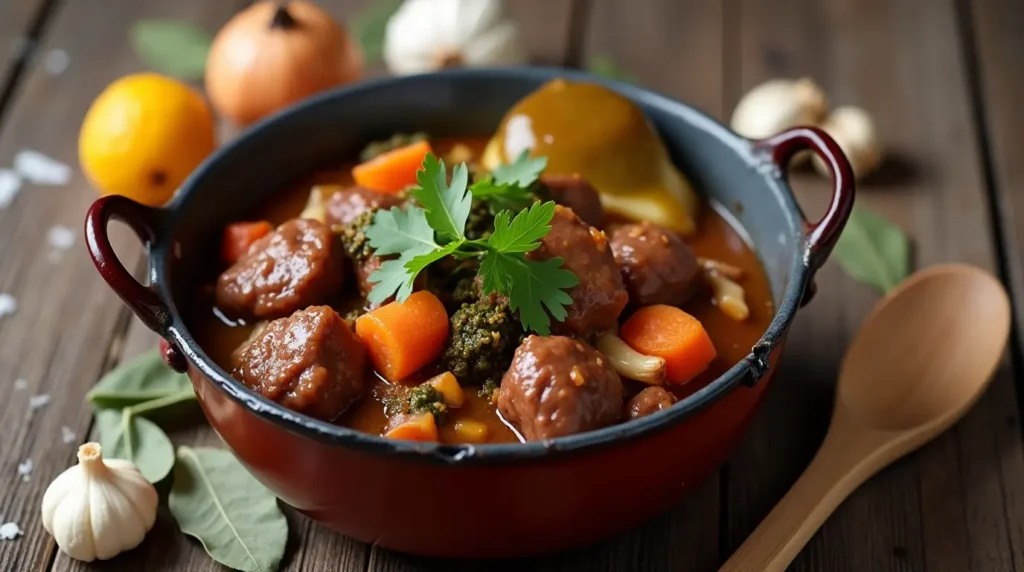
Table of Contents
Selecting the Perfect Cut of Beef
Making an exceptional boeuf bourguignon starts with picking the right cut of beef, and that’s a significant part of the process. Our kitchen experiments with different cuts have taught us the meat’s characteristics make all the difference.
Understanding different beef cuts for bourguignon
The best cuts for boeuf bourguignon need plenty of collagen and connective tissue. These options work really well:
- Chuck roast: Our preferred choice that’s affordable and reliable
- Beef shin: Great choice thanks to its high gelatin content
- Beef cheek: Gives you that sweet spot between meat and tenderness
- Short ribs: Packs deep beefy flavor, though it costs a bit more
Something we’ve learned the hard way: stay away from pre-packaged stew meat. These pieces usually come from different parts of the cow and don’t cook evenly, which leads to mixed results.
Optimal meat-to-fat ratio
The perfect boeuf bourguignon needs more than just tough meat – it needs the right amount of marbling. Look for meat with white streaks of fat running through it. This fat keeps everything moist and tender as it cooks.
People often think more fat equals better results. Fat helps, but too much can spoil the dish. You want meat with nice marbling without excessive fat on the outside.
How to check meat quality
Here’s what we look for at the butcher:
The meat should show good marbling without being fatty. The collagen content plays a vital role – it turns into gelatin while cooking and creates that luxurious texture we want.
Cutting your own chunks works better than buying pre-cut stew meat. We cut pieces about 1½ to 2 inches big. This size works perfectly since smaller pieces tend to dry out during long cooking.
A tip about chuck roast (our favorite cut): check that the marbling spreads evenly through the whole piece. Supermarket cuts can be hit-or-miss, so it’s worth building a relationship with a good butcher who’ll help you pick the best pieces.
Mastering the Wine Selection
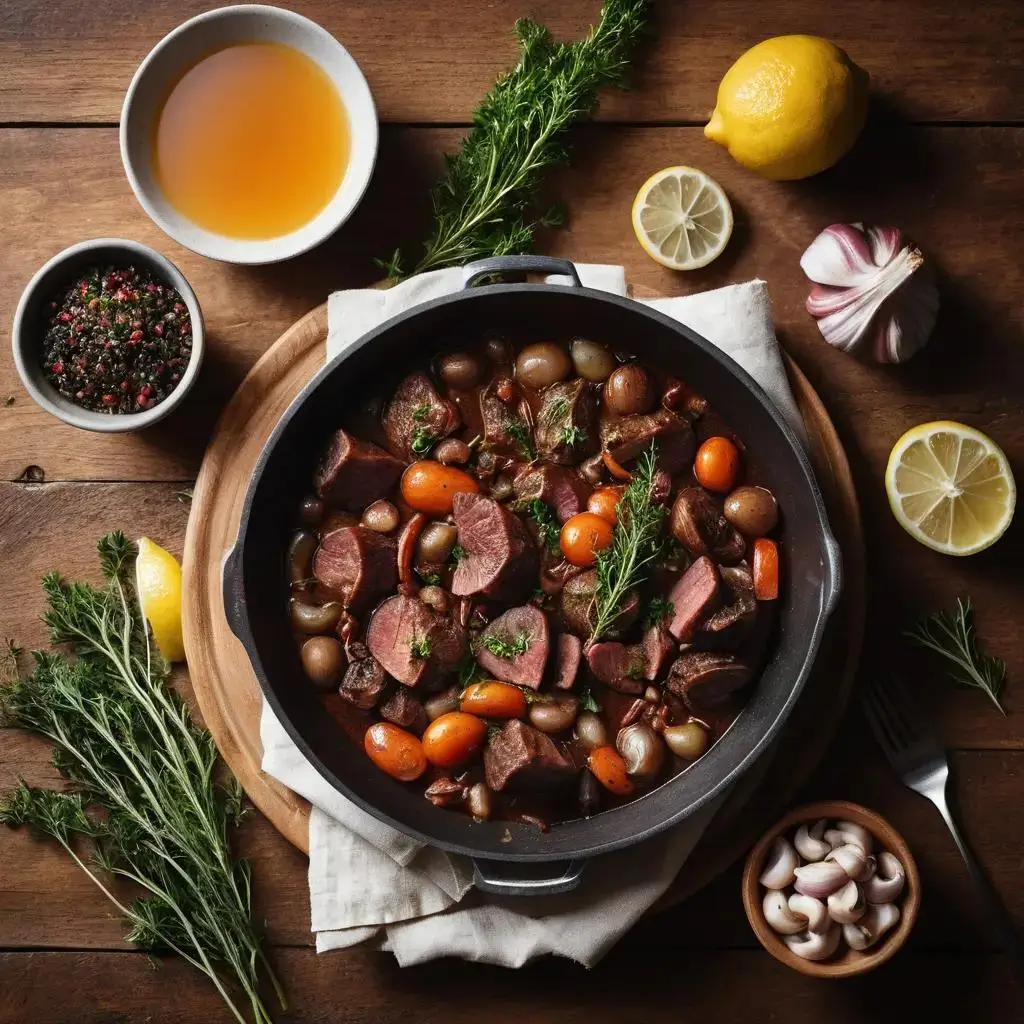
The magic of exceptional boeuf bourguignon comes from both wine selection and meat choice. I’ve spent years trying different wines and found that this classic French dish just needs the right wine in your pot.
Best wine varieties for cooking
My experience shows Pinot Noir as the classic choice for boeuf bourguignon, especially when you have varieties from Burgundy or Oregon regions. A good cooking wine should have these qualities:
- Full-bodied reds with good acidity
- Strong flavors that complement the meat
- Wines with balanced tannins
- Varieties that offer depth and complexity
Pinot Noir guides the way, but I’ve created amazing dishes with Cabernet Sauvignon from Bordeaux or Napa Valley, and Syrah from the Rhône Valley or Barossa Valley. Each wine adds its own character to the dish while keeping the essential flavor profile intact.
Price vs quality considerations
People often ask me about wine pricing. My experience shows you don’t need expensive bottles, but the cheapest options won’t work either. The cooking process concentrates wine flavors, making any flaws more noticeable.
My golden rule is simple: if you wouldn’t drink it, don’t cook with it. Your wine’s flavor shapes the richness, acidity, and depth of the sauce. A slightly more expensive wine makes a noticeable difference in your final dish.
Wine substitution options
You might need alternatives to traditional wine choices. My test batches have shown several substitutes that give excellent results:
Non-alcoholic options work well with a mix of beef broth and a splash of red wine vinegar. This keeps the dish’s depth while adding needed acidity. I dilute vinegar with equal parts water for balanced flavor.
Merlot and even Beaujolais work great as alternative wines. A dry red wine works better than sweet varieties since sweetness can overpower the dish’s savory elements.
The wine does more than add liquid – it builds flavor layers. The best results come from wines that complement the beef’s natural flavors. Your chosen wine’s characteristics become more concentrated as you cook.
Essential Preparation Techniques
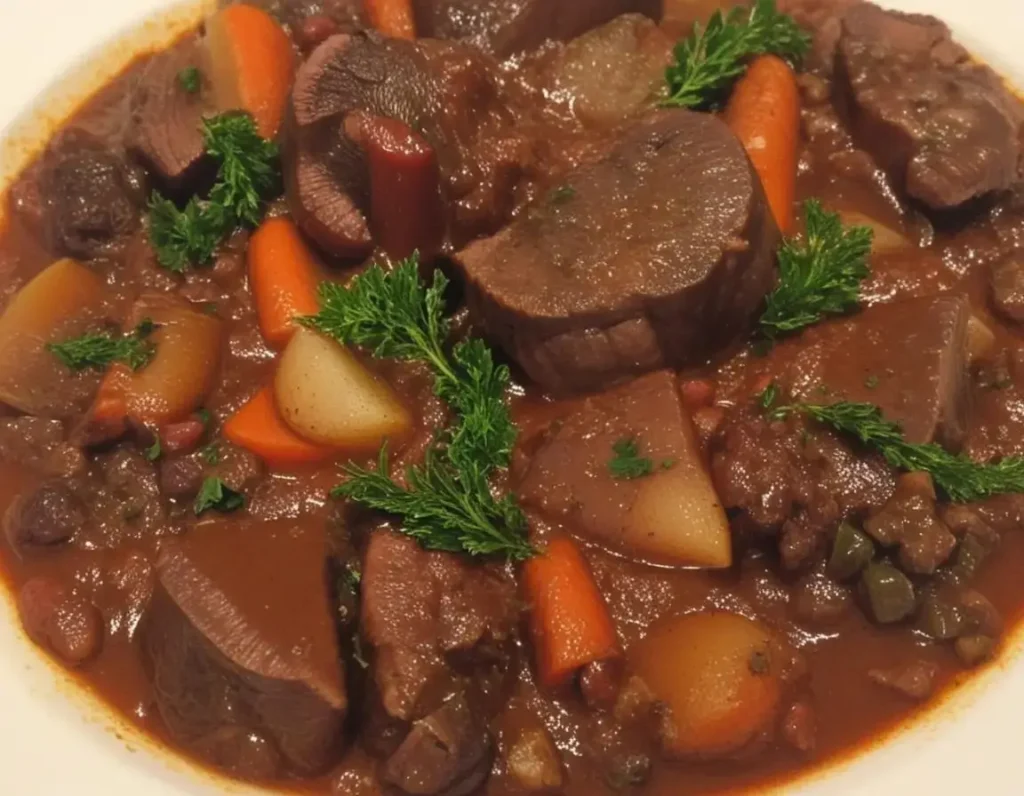
The perfect cut of beef and wine needs proper preparation to create an outstanding boeuf bourguignon. My countless attempts have taught me that attention to detail during this phase can reshape the scene from a good dish to an exceptional one.
Proper meat trimming and cutting
The chuck roast needs to be divided along its natural sections, which fat streaks separate. My fingers help identify tough spots that need removal during trimming. The chunks should be about 1½ to 2 inches in size because smaller pieces tend to dry out during the long cooking process.
A significant step you can’t skip is removing excess external fat while keeping the internal marbling intact. This balance will give a moist texture without becoming greasy. A cup or two of trimmed waste is perfectly normal.
Marinating dos and don’ts
Years of testing have taught me some essential marinating principles. Here are my key findings:
- Pat the meat completely dry before marinating
- Use aromatics like carrots, onions, and bay leaves
- Marinate for at least 8 hours, ideally overnight
- Keep the meat refrigerated during marination
- Avoid marinating for more than 24 hours
The sort of thing I love is that some chefs advise against marinating, warning about an overly gamey flavor. But my experience shows that proper marination boosts the dish when done correctly.
Temperature control tips
Temperature management is vital throughout the cooking process. Here’s my proven approach:
- Remove marinated meat from refrigeration 30 minutes before cooking
- Pat the meat really dry with paper towels before searing
- Maintain a constant, moderate oven temperature of 350°F
- Keep the liquid at a gentle simmer, never a full boil
My game-changing discovery shows that oven cooking provides more consistent results than stovetop cooking. Even heat distribution helps prevent the bottom from catching and eliminates the need to stir constantly.
The biggest problem I see is rushing the temperature transitions. The pan needs to cool slightly before adding wine or stock to prevent the flour from burning. This patience pays off in the sauce’s final texture.
Note that the goal isn’t just to cook the meat but to turn its tough collagen into silky gelatin. This transformation happens only with proper temperature control and timing. Monitoring the liquid level during cooking is essential – if it reduces too quickly, add hot water to maintain the right consistency.
Perfect Browning Methods
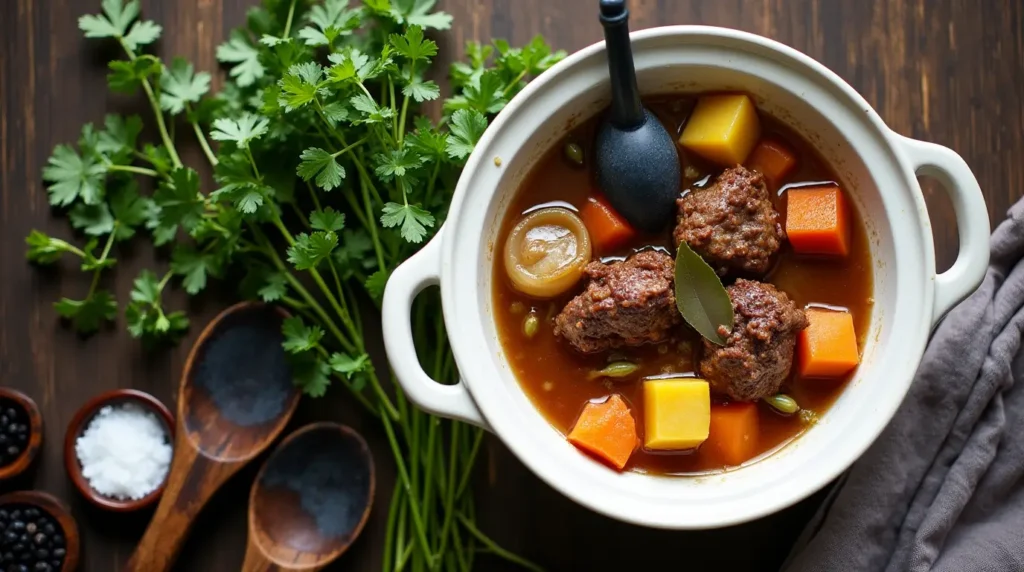
My journey to perfect boeuf bourguignon taught me that most home cooks struggle with the browning process. The rich, deep flavor comes from getting the perfect sear through what scientists call the Maillard reaction – a process that needs temperatures above 300°F.
Achieving the ideal sear
The secret to successful browning lies in high heat and a dry environment. Here’s my proven process:
- Pat the meat completely dry with paper towels
- Heat the pan until it’s screaming hot
- Add meat in a single layer with at least 1 inch between pieces
- Resist the urge to move the meat as it cooks
- Season with salt only after placing in the pan
My experience shows that the meat’s surface dryness plays a vital role in creating that perfect brown crust. Moisture acts as a temperature regulator and stops the meat from reaching those high temperatures needed for proper browning.
Common mistakes
My countless attempts at beef bourguignon helped me spot several pitfalls that can ruin your browning:
- Overcrowding the pan: This leads to steaming rather than browning
- Constant stirring: This prevents the formation of a proper crust
- Adding salt too early: This draws out moisture, hindering browning
- Using cold meat: This drops the pan temperature too quickly
Rushing the process creates the biggest problems. Crowded meat in the pan substantially drops the temperature. You’ll end up with gray, steamed meat that lacks that vital flavor development.
Equipment considerations
My kitchen experiments with various pans showed that cookware choice substantially affects results. Nonstick pans work but are nowhere near as effective as stainless steel or cast iron.
Cast-iron skillets give the best results due to superior heat retention. You’ll need a pan at least 10 inches wide for browning one pound of meat. Larger batches of boeuf bourguignon need multiple cooking rounds instead of cramming everything into one pan.
Temperature control makes all the difference. My method involves preheating the pan for about 5 minutes before adding oil or meat. This will give a surface temperature high enough to trigger the Maillard reaction the moment meat touches the pan.
Professional kitchens taught me to listen for the sizzle. A sharp, crackling sound means you’re doing it right. A low, wet sputter signals your pan isn’t hot enough. This audio cue became my most reliable indicator of proper browning conditions.
Sauce Development Secrets
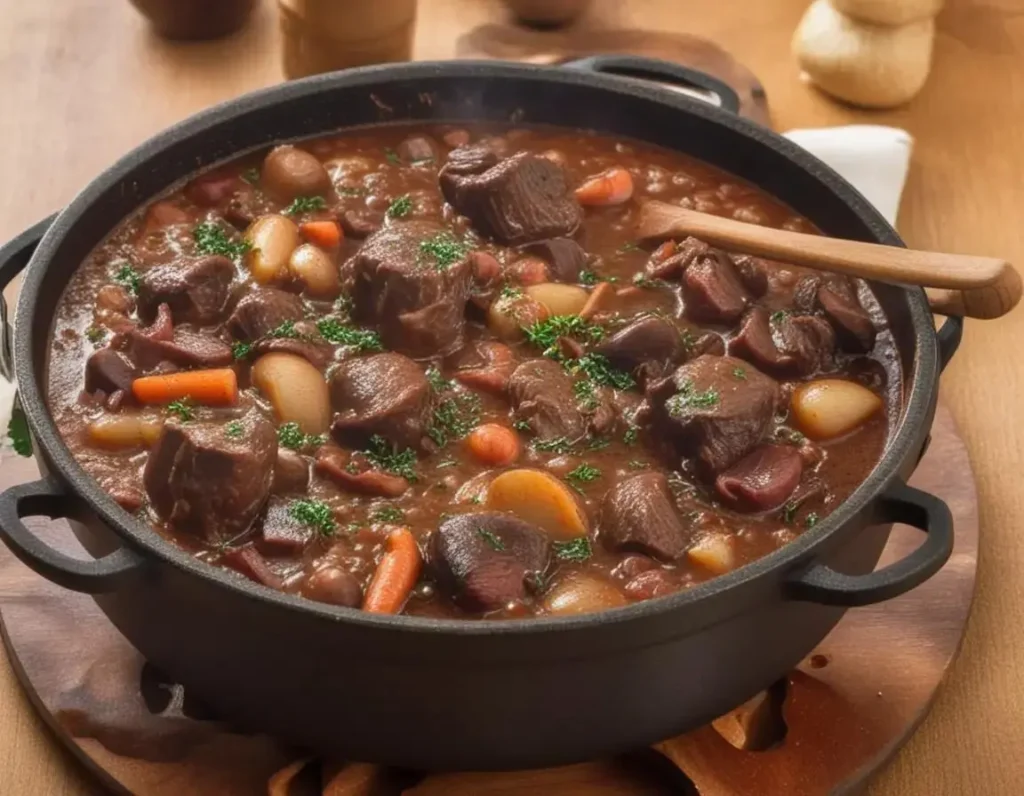
The perfect sauce for boeuf bourguignon blends science and artistry in the kitchen. Years of testing and refining have shown me that success comes from understanding how each ingredient adds to the final dish.
Building depth of flavor
A great sauce starts with what French chefs call “fond” – those rich browned bits stuck to the pan after searing the meat. These caramelized pieces pack rich, roasted aromas and flavors that come from the Maillard reaction.
My game-changing approach uses dry, fruity red wine to deglaze the pan. Pinot Noir or Cabernet Sauvignon work best because they create deeper, richer sauces. A splash of French brandy – Cognac or Armagnac – adds another layer of complexity and builds remarkable depth.
Proper reduction techniques
The right temperature makes all the difference when reducing the sauce. Boiling it too hard doesn’t just toughen the meat – it strips away those subtle aromatic flavors that make boeuf bourguignon special.
My proven reduction process looks like this:
- Start with a gentle simmer, never a full boil
- Keep the pot partially covered
- Check consistency every 15-20 minutes
- Add hot stock if needed to maintain proper liquid level
- Reduce until the sauce coats the back of a spoon
Thickening methods
Experience has taught me several ways to get the perfect sauce consistency. These are my favorite methods:
- Traditional Flour Method: Coating the meat with flour before browning helps thicken naturally during cooking
- Cornstarch Slurry: Mix cornstarch with cold water for last-minute adjustments
- Natural Reduction: The sauce sometimes just needs time to reduce slowly
- Roux Method: A dark caramel-colored roux adds incredible depth
Ground dried porcini mushrooms work great as a thickener – they improve consistency and add an amazing umami boost.
When your sauce tastes too acidic (which can happen with some wines), a tiny pinch of baking soda helps balance it. You should be very careful though – too much creates a soapy taste.
Some traditional recipes suggest adding a pig’s foot during cooking to create the ultimate depth of flavor. Its natural gelatin makes the sauce luxuriously rich. This might sound unusual, but nothing else matches the texture it creates.
The right temperature matters throughout the whole process. A gentle simmer and careful heat adjustments prevent the sauce from breaking or becoming grainy. This patience leads to a silky, complex sauce that perfectly coats each piece of meat.
Vegetable Timing and Texture
Getting vegetables right in boeuf bourguignon resembles conducting an orchestra. Each component must enter at the perfect moment. My many attempts at perfecting this dish taught me that vegetable timing can make or break the final result.
When to add each component
Traditional boeuf bourguignon needs four most important vegetables:
- Carrots: Added during the main cooking process
- Pearl onions: Sautéed separately and added later
- Mushrooms: Always cooked separately in butter
- Garlic: Used in the original aromatics
A two-stage approach with vegetables works best. The first batch enhances the sauce’s flavor early on. Fresh vegetables added later give the perfect texture.
My experience shows mushrooms need special care. They must be sautéed separately in butter until golden and caramelized. This step keeps them from becoming rubbery and bland – a common issue with mushrooms tossed directly into the stew.
Maintaining vegetable integrity
Vegetable integrity depends on temperature control. The best results come from cooking vegetables between 160 to 180°F. These temperatures let them become tender while keeping their structure.
Carrots and pearl onions need light browning for about 10 minutes. This creates a protective barrier that helps maintain their shape during final cooking.
Your vegetables’ cut size matters. Uniform cuts ensure even cooking and better presentation. Carrots work best at 1/2-inch slices. Mushrooms should be quartered instead of sliced to keep their texture.
Texture balance tips
My years of testing led to this foolproof method for perfect vegetable texture:
- Start with large aromatic vegetables for the original cooking phase
- Remove these early vegetables once they’ve given their flavor
- Add fresh, perfectly cut vegetables about 30 minutes before finishing
- Monitor the liquid level to prevent vegetable breakdown
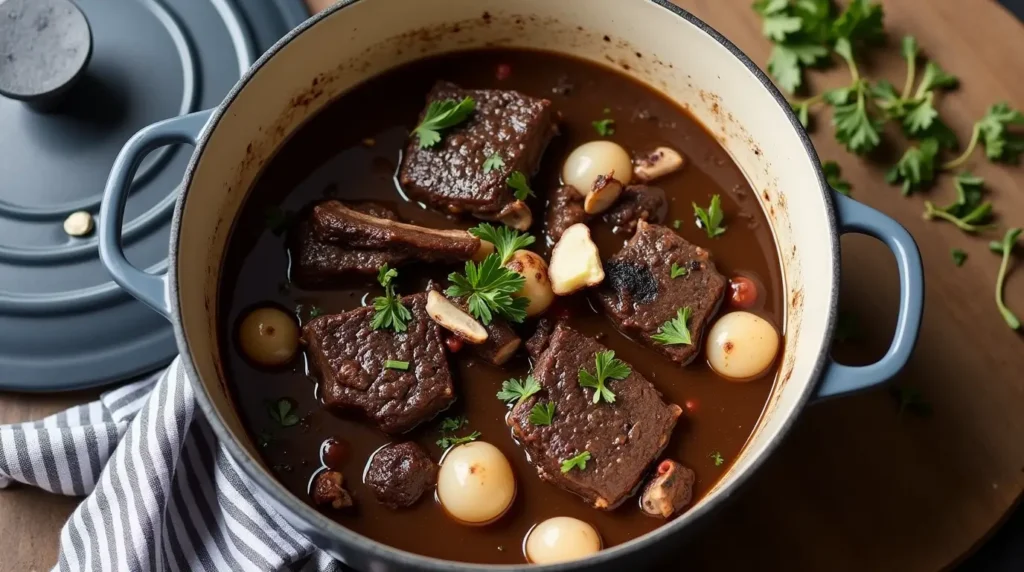
My game-changing technique uses large aromatics for cooking, then discards them before adding fresh diced vegetables. This gives deep flavor from the original vegetables and perfect texture from the finishing ones.
Larger quartered mushrooms make a big difference. They won’t shrink too much and keep their meaty texture.
Many cooks add all vegetables at once – that’s a mistake. Root vegetables like carrots go in first. Other components follow based on their cooking times. This layered approach lets each vegetable reach its best texture without becoming mushy.
The last 30 minutes are vital. Fresh vegetables added then get just enough time to become tender while keeping their character. Hot liquid added gradually will maintain the perfect consistency if the sauce thickens too much.
Conclusion
Perfect boeuf bourguignon just needs attention to detail. These most important elements will change your results completely. My experience with countless attempts shows that success comes from careful meat and wine selection, proper browning techniques, patient sauce development, and strategic vegetable timing.
Each component is a vital part – from selecting well-marbled chuck roast to keeping gentle heat throughout the cooking process. Your final dish improves significantly when you pat the meat dry before searing, use the right wine, and add vegetables at the perfect moment.
These techniques will help you create a boeuf bourguignon worthy of any French bistro. Your first attempt might not be perfect, but you’ll understand how these elements work together better each time you make this classic dish. You’ll become skilled at this timeless recipe and make it your own naturally.
FAQs
Q1. What’s the best cut of beef for Boeuf Bourguignon? Chuck roast is the preferred cut for Boeuf Bourguignon. It’s an affordable option that provides the right balance of meat and fat, ensuring tender results after long cooking. Look for a well-marbled piece with visible streaks of fat throughout.
Q2. How do I select the right wine for cooking Boeuf Bourguignon? Choose a full-bodied, dry red wine like Pinot Noir or Cabernet Sauvignon. The wine should be good enough to drink but doesn’t need to be expensive. Avoid sweet wines as they can overpower the dish. Remember, the wine’s flavor will concentrate during cooking, so select one that complements the beef.
Q3. What’s the secret to achieving a perfect sear on the meat? The key to a perfect sear is high heat and a dry surface. Pat the meat completely dry before cooking, use a screaming hot pan, and avoid overcrowding. Add the meat in a single layer with space between pieces, and resist the urge to move it while it’s browning. This process creates a flavorful crust essential for the dish.
Q4. How long should Boeuf Bourguignon cook for the best results? Cooking time can vary, but generally, Boeuf Bourguignon needs at least 3-4 hours of gentle simmering to achieve tender meat and a rich sauce. The dish is done when the meat easily falls apart with a fork. Avoid boiling, as this can toughen the meat and drive off subtle flavors.
Q5. How do I ensure the vegetables in Boeuf Bourguignon have the right texture? Add vegetables in stages for the best texture. Start with large aromatic vegetables for flavor, then remove them. Add fresh, uniformly cut vegetables about 30 minutes before finishing. Cook mushrooms separately in butter until golden. This approach ensures each vegetable reaches its optimal texture without becoming mushy.

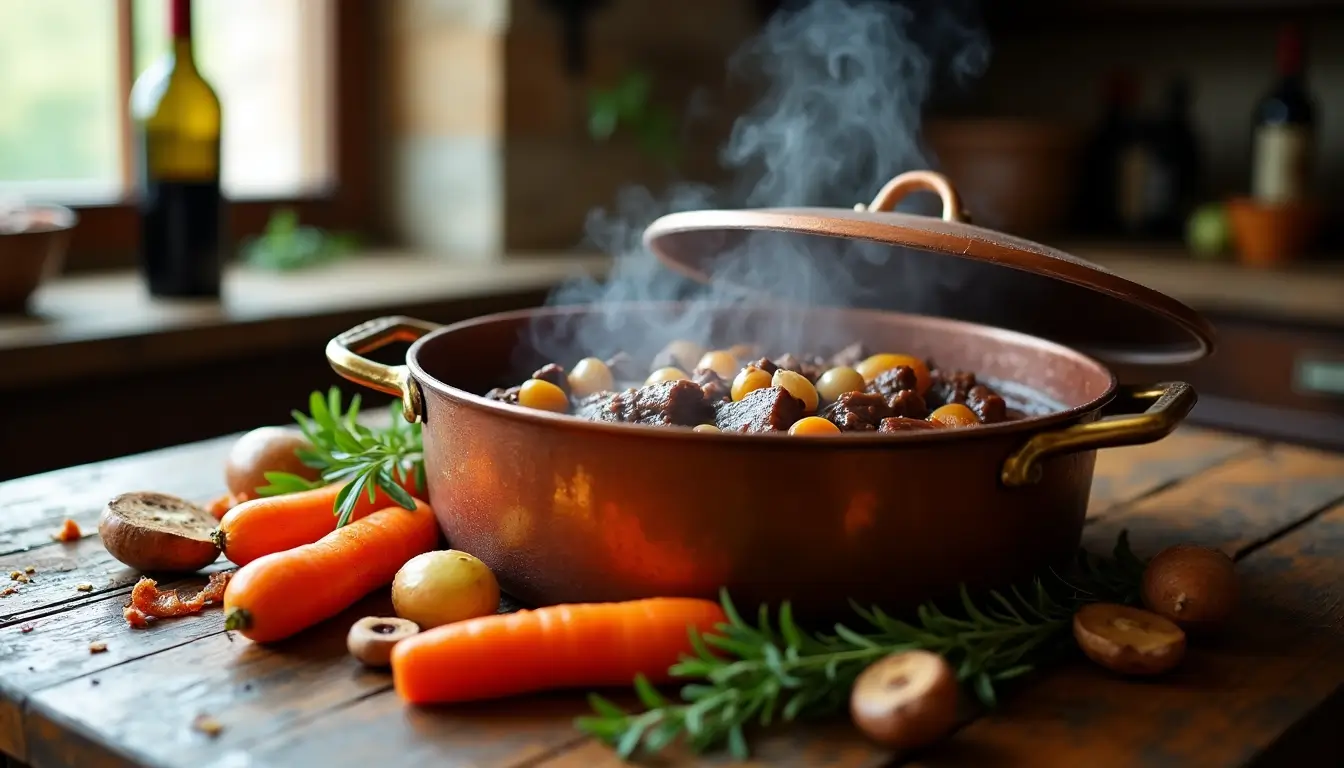
1 thought on “7 Essential Tips for Cooking Perfect Boeuf Bourguignon”
Comments are closed.